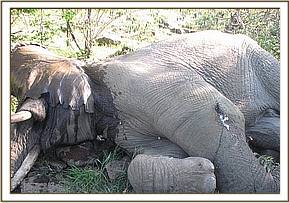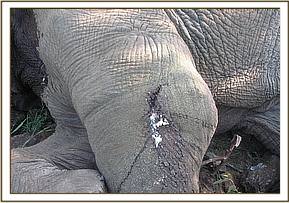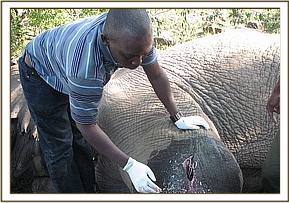Summary The Mara veterinary unit was involved in a number of activities during the month of January, these included treatment of a female buffalo with papillomatosis in Masai Mara National Reserve and treatment of a wounded elephant in Naiboshio conservancy
Summary The Mara veterinary unit was involved in a number of activities during the month of January, these included treatment of a female buffalo with papillomatosis in Masai Mara National Reserve and treatment of a wounded elephant in Naiboshio conservancy. The veterinary unit in Masai Mara urgently requires adequate electricity to run a sample bank fridge in the camp, without which most of the samples will deteriorate before being analysed. All the veterinary activities went on successfully during the month as reported below.
Papillomatosis in a buffalo (Syncerus caffer) in Masai Mara
An adult female buffalo was sighted with signs of papillomatosis in Masai Mara National Reserve, the buffalo was in a large herd of about 300 buffaloes. It had developed whitish couliflower-like warts covering the ears, mandibles and around the eyes, some extended to the neck and even shoulder region. The warts were generally dry and some were loosely attached and almost falling off.
Immobilization and examination of the lesions
The buffalo was captured by darting from the vehicle using 4mgs of etorphine combined with 30mgs of xylazine, it was darted at close range of about 20 meters away. It took about 5 minutes for the drug to take effect and it went down. The lesions were scrapped off by scalpel blade and samples collected for virus isolation and identification. Blood samples were also collected for haematology tests. The buffalo was later treated by amoxicillin (Betamox) for any secondary bacterial infection, the lesions were also treamed off surgically and sprayed with oxytetracycline spray. None of the animals in the herd had such infection. The disease is self limiting and the buffalo is expected to recover soon. Papillomatosis is a disease of most domestic and wildlife species characterized by formation of warts on the affected skin surfaces (cutaneous papillomatosis) or mucous membrane papillomatosis. This condition is caused by papilloma viruses which are small double-stranded DNA viruses of the Papovaviridae family. Most warts appear as epidermal proliferations that have a keratotic surface resembling a cauliflower known as verruca vulgaris. The virus is highly species specific and some mammals have several distinct papilloma viruses e.g human have >20, cattle 6, dogs 3, and rabbits 2. The viruses are usually transmitted by direct contact, formites and possibly by insects. Papillomas have been reported in all domestic animals, birds, fish and some wildlife species such as white-tailed deers, black-tailed deers, mule deers, several antelope species, moose and caribou.
Diagnosis:
When wart lesions are multiple, they may be sufficiently characteristic to confirm the diagnosis, however, there are many simulants of warts and definitive diagnosis can only be confirmed by virus isolation and identification.
Treatment and control:
Papillomatosis is a self-limiting disease (can heal spontaneously without clinical intervention) though the duration of the warts varies considerably and may last long in some species of animals. Surgical removal is recommended if the warts are sufficiently objectionable, the best time for surgical removal is when the warts are near maximum size or have started regressing. Sometimes the disease may become a herd problem with several young animals or older animals infected; in such cases the affected animals should be isolated from susceptible ones. When the disease is a herd problem, it can be controlled by vaccination using a suspension of ground wart tissue in which the virus has been killed by 40% formaldehyde (formalin) as demonstrated by Hunt, 1984.



Treatment of a wounded male elephant in Naiboshio conservancy in Masai Mara.
This was a case of a sub-adult male elephant which had an infected wound on the lateral side of the left front leg around the cubic (elbow joint) in Naiboshio conservancy within the Mara ecosystem. The wound was slit open and seemingly caused by a sharp object. It was much infected with a lot of necrotic debris and pus oozing out from the opening. The dorsal part of the leg above elbow joint was swollen and the animal was in much pain almost unable to walk. This required an urgent veterinary intervention.
Chemical immobilization, examination and treatment
The elephant was darted on foot using 17mgs of etorphine Hcl combined with 3000 i.u on the left thigh. The drug took effect after about 6 minutes and it became recumbent. The wound was then examined for the presence of any foreign material but there was none, the injury was slit opened using a surgical blade and probed by long haemostat forceps and gauze swabs. The wound was then pressed and cut open to drain all the pus and necrotic debris completely. It was also cleaned and debrided using 10% hydrogen peroxide draining all the accumulated pus and necrotic tissue debris, then treated using a topical application of a tincture of iodine and oxytetracycline spray. The wound was then covered with green clay powder which maintains wound cleanliness, repel flies and enhance pus drainage. Further treatments by intramuscular administration of long-acting Amoxycillin (Betamox) antibiotics and flunixin meglumine were provided. Prognosis was quite good after treatment and the elephant is expected to recover from the injury soon.




Acknowledgements
Kenya Wildlife Service (KWS) acknowledges the continous support of the David Sheldrick Wildlife Trust towards provision of wildlife veterinary services in Masai Mara ecosystem this has significantly contributed to the general wildlife health and conservation in the Mara ecosystem. We also acknowledge the support of the KWS rangers and staff from Masai Mara National Reserve, Mara North conservancy, Naboishio conservancy and the surrounding community-owned wildlife conservancies for continuous support and reporting of wildlife incidences requiring veterinary intervention in the Mara ecosystem.
Report by: Dr. Domnic Mijele